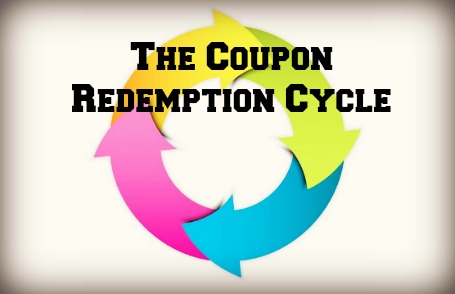This post may contain affiliate links. Read our disclosure here.

Do you ever get the evil eye for using coupons? If you don’t then odds are you could use to cut a few more the next time you go to the store! Sadly so many people have a ill conceived notion that we are robbing the stores. While there are some that lack ethics and have a negative impact on the store, those of us following the rules of coupons are not impacting the store in any way other than increasing their bottom line!!
To help you stand strong in your coupons, I thought it was time to dust off an old lesson in the coupon redemption cycle. I originally posted this in January of 2009, I’ve updated a few things that have changed in the last 4-5 years too.
The Life Cycle of a coupon:
1. The manufacturer decides to run a coupon program and sends the coupon to a design agency that handles coupons.
2. You acquire the coupon through the paper, printables, magazines etc.
3. You use the coupon, the store takes the coupon
4. At the end of the night the cashier adds up her coupons and cash to make sure the drawer balances.
5. The coupons are then bagged by the store and sent to the corporate office where all the coupons from all the stores are put into a bigger bag and sent to a big clearing house. (note some stores do this in house)
6. The clearing house puts all the coupons that are in good condition on a big conveyor belt and they are scanned, then an automated process sorts them by manufacturer and prepares an invoice for the manufacturer.
7. They are mailed from the clearing house to the manufacturer for reimbursement.
8. The manufacturer receives the coupons and an invoice stating how many are there (think thousands). They then pay the bill. Some will recount to check for clearing house fraud and then pay the bill.
Mobile Coupons: Have a similar pattern except it is a data file sent to the clearing house and manufacturer.
How the stores get their money:
- They can be paid directly by the clearing house – then the clearing house gets reimbursed from the manufacturer
- They can pay a handling fee to the clearinghouse and they get a check from the manufacturer
Reimbursement also includes .08¢ per coupon to cover handling fees and the manufacturer’s reimburse postage costs!
Now for the details we care about:
If the coupon scans in the store odds are it will also scan in the big clearing house’s automated machine – thus the store should get reimbursed.
If the coupon doesn’t scan, is damaged etc. it is labeled “hard to handle” and is hand processed. If it is the coupons fault (poor design, bad barcode etc.) the grocer can then charge the manufacturer a higher handling fee!
The store does not have to submit any information about what you purchased with the coupon.
When does the store “lose” money?
Some Manufacturers have poor practices with redemption that has nothing to do with the consumer, claiming falsely that coupons are not eligible for one reason or another. We have seen this in the largest scale by Procter & Gamble over the years claiming coupons were “gang cut” and then refusing to reimburse any of them. Thankfully P&G changed wording on their coupons to limit all coupons to 4 like per transaction.
Copies/fraudulent coupons- Sadly there are people who sit at home and in their spare time make fake coupons. If you ever get an email with printable coupons that are huge values and you can print as many as you want… yeah they are fraudulent. There are no $9 off Tide coupons, I promise! If a store ever takes any of these, they will not be reimbursed for them. It is these coupons that have made stores bitter about coupons. Read up on how to spot fraudulent coupons. You can also go here and see the list of all currently known fraudulent coupons.
Store coupons:
These are processed in house. First, most people assume these coupons are the store being nice and just giving you money off an item…let’s think about that. This is a business guys, it’s not about being nice.
Stores are reimbursed for “store coupons” through various options:
1. The manufacturer can pay an advertising fee to place their product or coupon in the store flyer.
2. The manufacturer can work out a discounted deal for X product, the store then decides instead of making the product the discounted price for everyone, to require customers to submit a coupon to get that price. This is the best plan overall, most shoppers would not care or know about the coupon so they only have to sell the product at the discounted price to a small percentage of shoppers. Therefore they make money on the other shoppers.
Fake Example (profit widely inflated):
Fresh Express Bagged Salad gives Publix a discounted rate of $1 per bag for 500 bags.
Publix decides to sell the bag for $3 and to put a coupon in the flyer for $2 off.
100 customers buy the salad with a coupon
400 customers buy the salad without a coupon ($2 profit per bag for Publix)
In the end: Publix gave 100 customers the salad without making any profit, however overall they made $800 off the deal.
3. Lastly the store can have a special reimbursement policy with the manufacturer for the store coupons. So they are handled like actual manufacturer coupons above.
The only time they are not getting reimbursed for these coupons in some way is if it is for a house brand item. Keep in mind those are the items they make the most money on so they still aren’t really out anything.
In closing: I hope that gives you some idea of how coupons are handled. The intention of this post is not to encourage improper use of coupons only to make some realize that the use of coupons puts money back in the pockets of grocery store. We are not taking these stores to the cleaners. They are doing just fine.
About 15% of American’s shop with coupons (effectively), they get their money back from us through reimbursement programs above. 90% of Americans pay through the nose for groceries and they keep the profit always growing for these stores. To give you grocery store numbers… for 2012 Publix net earning rose 4% to 1.6 billion and Kroger for 2012 increased sales by 6% over the year before with net earnings of 1.5 billion. Obviously 2013 isn’t over yet, but so far every quarter has reported growth as well.
For more information check out:
NCH (Clearing House owned by Red Plum)
ProLogic
Kroger 2012 Profit Release
Publix 2012 Profit Release
Did I miss something you would like to know?
Leave a comment and I’ll do a Q&A post.


